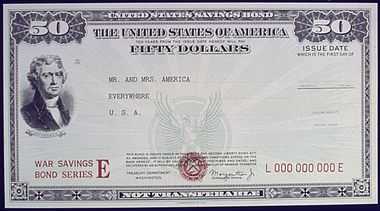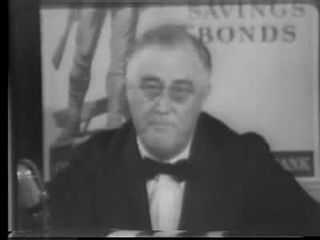Series E bond

Series E U.S. Savings Bonds were marketed by the United States government as war bonds from 1941 to 1980. Those issued from 1941 to November 1965 accrued interest for 40 years; those issued from December 1965 to June 1980, for 30 years. They were generally issued at 75 cents per dollar face value, maturing at par in a specified number of years that fluctuated with the rate of interest. Denominations available were $25, $50, $75, $100, $200, $500, $1,000, $5,000 and $10,000. Series E bonds were issued only in registered, physical form and are not transferable. The guaranteed minimum investment yield for the bonds was 4 percent, compounded semiannually.[1]
The U.S. Savings Bond programs
The first modern U.S. Savings Bonds were issued in 1935, to replace United States Postal Service Bonds. They were marketed as a safe investment that was accessible to everyone. The first bonds, series A, were followed by series B, C, D, E, EE, F, G, H, HH, and I.
Financing World War II
In December 1941, the US declared war on Japan and Germany declared war on the US shortly thereafter. This was the starting point for a large scale – and thus expensive — defense program. The problem of the financing of World War II was greater than that of World War I, as the struggle lasted longer and the amounts involved were larger.
The budgetary expenses for the years 1941–1945 amounted to some $317 billion, of which $281 billion was directly related to the war effort; expenditures climbed from $9.6 billion in fiscal 1940 to nearly $100 billion in 1945. Of these outlays some 45 percent was covered by taxes and other non-borrowing sources. The deficit had to be covered by selling bonds. The Treasury sold $185.7 billion of securities to finance the war. The public debt rose from $50 billion in 1940 to $260 billion in 1945.[2]
| Year | Receipts ($ bn) | Outlays ($ bn) | Deficit ($ bn) | Public Debt ($ bn) |
|---|---|---|---|---|
| 1939 | 6.6 | 9.4 | 2.9 | 48.2 |
| 1940 | 6.9 | 9.6 | 2.7 | 50.7 |
| 1941 | 9.2 | 14.0 | 4.8 | 57.5 |
| 1942 | 15.1 | 34.5 | 19.4 | 79.2 |
| 1943 | 25.1 | 78.9 | 53.8 | 142.6 |
| 1944 | 47.8 | 94.0 | 46.2 | 204.1 |
| 1945 | 50.2 | 95.2 | 45.0 | 260.1 |
| 1946 | 43.5 | 61.7 | 18.2 | 271.0 |
War Bonds

The first Series E Bond was sold to President Franklin D. Roosevelt by Secretary of the Treasury Henry Morgenthau on May 1, 1941.[3] These were marketed first as "defense bonds", then later as "war bonds".
During World War II the "drive" technique used during World War I was replaced in part by a continual campaign using a payroll deduction plan. However, eight different drives were conducted during the campaign, in total raising $185.7 billion from 85 million Americans, more than in any other country during the war.[4] Li'l Abner creator Al Capp created Small Fry, a weekly newspaper comic strip whose purpose was to sell Series E bonds in support of the Treasury.[5] The eight specific drives, their goals, and amounts raised, were as follows:
- First War Loan Drive – began November 30, 1942, and ended December 23, 1942. The initial goal was $9 billion; the drive raised $13 billion. However, only $1.6 billion was raised from individuals; corporations and commercial banks accounted for the vast majority of the funds raised.
- Second War Loan Drive – began April 12, 1943, and ended May 1, 1943. The initial goal was $13 billion; the drive raised $18.5 billion. Individual purchases doubled over the previous drive, due in large part to the $4.5 million and $170,000 of advertising contributed by newspapers and magazines.
- Third War Loan Drive – began September 9, 1943, and ended October 1, 1943. The initial goal was $15 billion, which would require a doubling of the bond sales from the prior drive, with at least 40 million of the 130 million American citizens needing to purchase a $100 war bond. President Franklin D. Roosevelt addressed the nation via one of his fireside chats on September 8 and Kate Smith raised $39 million during a September 21 CBS broadcast.[6] Final sales were $19 billion.
- Fourth War Loan Drive – began January 18, 1944, and ended February 15, 1944. The initial goal was $14 billion, and the drive was targeted towards farmers and women. Final sales were $16.7 billion (107% of quota) and nearly 70 million separate bonds sold.
- Fifth War Loan Drive – began June 12, 1944, and ended July 8, 1944. On May 15, 1944, Orson Welles was placed on the U.S. Treasury payroll as an expert consultant for the duration of the war (with a retainer of $1 a year).[7] On FDR's recommendation, Morgenthau asked Welles to lead the Fifth War Loan Drive, which opened June 12 with a one-hour radio show on all four networks, broadcast from Texarkana, Texas. Including a statement by the President,[8] the program defined the causes of the war and encouraged Americans to buy $16 billion in bonds. Additional war loan drive broadcasts took place June 14 from the Hollywood Bowl, and June 16 from Soldier Field, Chicago.[9]:371–373 Americans purchased $20.6 billion in War Bonds during the Fifth War Loan Drive.[4]
- Sixth War Loan Drive – began November 2, 1944, and ended December 16, 1944. The drive raised $21.6 billion.[4]
- Seventh War Loan Drive – began May 14, 1945, just days after Victory in Europe Day. Officials were concerned that the defeat of Germany might lessen bond sales. Surprisingly, the amount raised during the six-week drive recorded sales of over $26 billion.[4][10]
- Eighth War Loan (Victory) Drive — began October 29, 1945, and ended December 8, 1945. The goal was $11 billion. More than $21 billion was raised — 192% of the goal.[4]
After the war
Although Series E bonds are usually associated with the war bond drives of World War II, they continued to be sold until June 1980, thereafter being replaced by Series EE bonds. A version of Series EE bonds, known as the Patriot Bond, is a sort of post-September 11 war bond, but has never enjoyed the broad subscription of the Series E war bond. These bonds are no longer available as of 2012.[11]
In October 2008, several news reports claimed there were several billion dollars in unclaimed bonds. The US treasury set up a web site called "Treasury Hunt." The system provides information only on Series E bonds issued in 1974 and after.
References
- ↑ SavingsBonds.com — E Savings Bonds, Investor Information
- ↑ Chapter Y Government, page 1105
- ↑ U.S. Treasury — Introduction to Savings Bonds
- ↑ 4.0 4.1 4.2 4.3 4.4 "Brief History of World War Two Advertising Campaigns War Loans and Bonds". Duke University Libraries. Retrieved 2014-02-21.
- ↑ "Presarvin’ Freedom: Al Capp, Treasury Man," Hogan's Alley, 1998
- ↑ Radio: Kate's Appeal - TIME
- ↑ "Orson Welles in War Loan Drive". Associated Press (Oakland Tribune), May 17, 1944
- ↑ "Opening Fifth War Loan Drive, June 12, 1944". Franklin D. Roosevelt Presidential Library and Museum. Retrieved 2014-02-21.
- ↑ Brady, Frank, Citizen Welles: A Biography of Orson Welles. New York: Charles Scribner's Sons, 1989 ISBN 0-385-26759-2
- ↑ Beall, C. C. (1945). "7th War Loan. Now--All Together". World Digital Library. Iwo Jima, Tokyo, Japan. Retrieved 30 June 2013.
- ↑ "The Patriot Savings Bond". U.S. Department of the Treasury, Bureau of the Fiscal Service. Retrieved 2014-02-21.
External links
| Wikimedia Commons has media related to World War II war bond posters from the United States. |